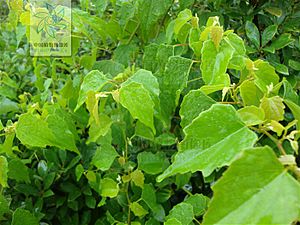Lobular grape facts for kids
Quick facts for kids Lobular grape |
|
|---|---|
 |
|
| Lobular grape observed in Fujian Province | |
| Scientific classification | |
| Genus: |
Vitis
|
| Species: |
sinocinerea
|
| Synonyms | |
|
V. thunbergii var. cinerea Gagnep.
|
|
The Vitis sinocinerea, often called the lobular grape or small-leaved grape, is a type of climbing plant. It belongs to the grape family. This plant grows across a large part of China, including places like Fujian, Hubei, Hunan, Jiangsu, Jiangxi, Yunnan, and Zhejiang. It also grows in Taiwan. In Chinese, its name is xiao ye pu tao, which means 'small-leaved grape'. You can find this plant in forests or on shrubby hills, usually at heights between 200 and 2800 meters.
Contents
What is the Lobular Grape?
The lobular grape is a liana, which is a fancy word for a woody vine that climbs up trees or other plants. It uses them for support to reach sunlight. This plant is part of the same family as the grapes you might eat!
Life Cycle and Appearance
The lobular grape plant starts to flower in May and June. Its flowers have petals that form a cap, which falls off as the flower opens. The male flowers have parts that look like they should make seeds, but they don't actually work. This means they can't produce fruit on their own.
After flowering, the plant grows fruit from July to October. The fruits are small, usually about 6 to 10 millimeters wide. They are dark purple or black, just like many other grapes.
Discovery of the Lobular Grape
The first official sample of the lobular grape was collected by a person named Ernest Henry Wilson. He found it in June 1907 in a place called Xingshan Xian, in Hubei province, China. He noted that the plant was either climbing or spreading over rocks, at heights between 600 and 1200 meters.
Later, in 1911, another scientist named François Gagnepain described the plant's features. He gave it the name cinerea, which was a type of V. thunbergii. This helped scientists understand more about this unique grape species.
Images for kids




